Laos is not a place one can forget.
One day I would like to go back there again in my travels.
It is a beautiful place with friendly people who welcomed me with open hearts.
It is also a place of sorrow because of war and loss.
Yet the people try to go on with their lives despite the war.
They live in hope and their beliefs keep them going.
There are tribes there who seem unaffected by western influence and change and keep to their tradition after all this time.
I met many children there, some happy, some sad.
I also spent time with a special family and also managed to enjoy the local food.
 War . . .
War . . .
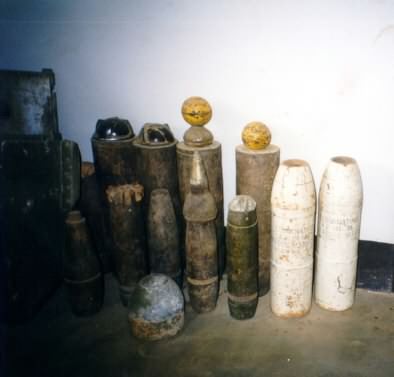
All the eastern parts of Laos was heavily bombed during the Vietnam War. More bombs were dropped in this area than the number of bombs dropped during the entire Second World War (approximately 10,000 bombs for every citizen of Laos). Laos has the sad reputation of being the most heavily bombed country in the world ...
Ever.
The Ho Chi Min trail went through Laos, and the Americans tried to destroy it with every means. They tried everything from carpet bombing, dropping cases of Budweiser Beer (hoping that the Vietnamese soldiers would get drunk) to dropping washing detergent during the wet season (hoping the trail would get slippery). It is estimated that the Americans only succeeded in stopping 10 percent of the traffic on the trail.
In Vietnam, the Americans were not allowed to bomb within 500 meters from temples and hospitals. Their rules of engagement furthermore said that they were not allowed to return to their home base with a bomb load. The result was that they flew across the border to Laos and dropped all their bombs there. In Laos, there were no rules of engagement. They could bomb whereever they wanted to bomb.
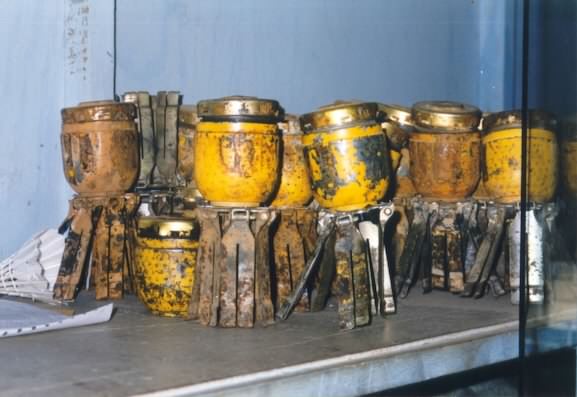
This also means that there is quite a large amount of UXO (Unexploded ordnance) in the country. Land mines and unexploded cluster bombs (shown on left) are some of the biggest problems.
In Laos, there are still approximately 4 accidents per day resulting from UXO.

Sad as this may seem, people have been pretty creative about using some of the leftover bombs. In this case they have used a couple of 2000-pound bombs as decoration outside the house.
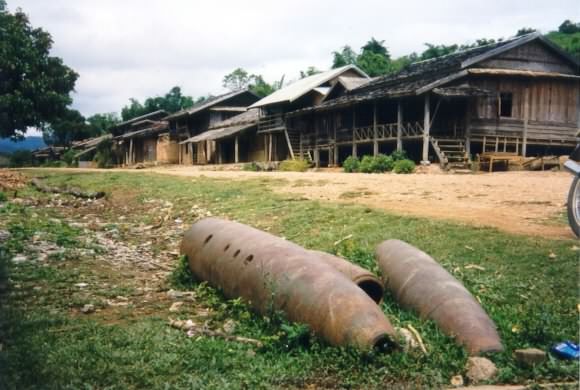
No matter where you go you are reminded of the war.
In all the local villages there are unexploded bombs and shells from the cluster bombs.

A lot of the remains from the war are sold as scrap metal. In this pile there are shells from cluster bombs, wheels from tanks etc. >>>

<<< Shells from the cluster bombs have been used to make this bridge.

Here as fence posts outside a house. >>>
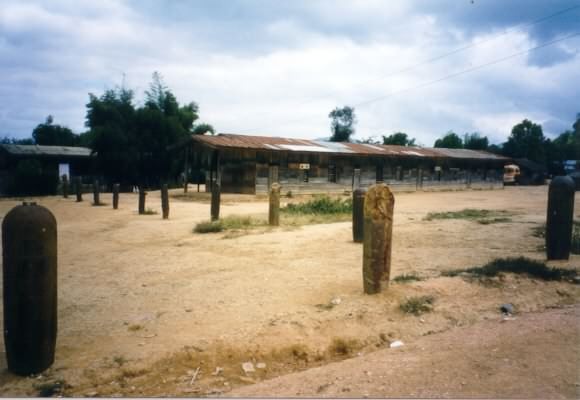
Outside a school, the schoolyard was surrounded by the shells from the American cluster bombs.

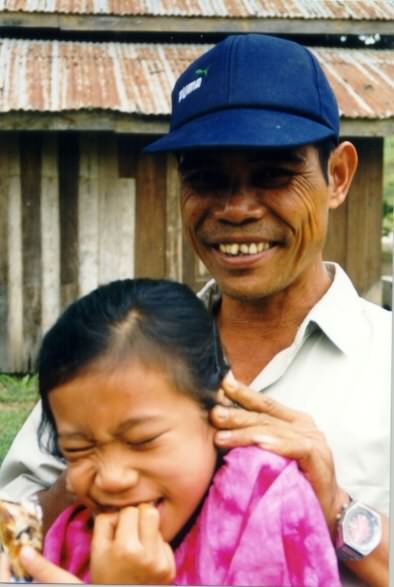 Sorrow . . .
Sorrow . . .This girl's parents were both killed by Hmong guerillas in 1997.
There are still areas where there are lots of problems with guerilla warfare. This is especially the case on Route 7, along the eastern border towards Vietnam and in the western part of Laos west of Vientiane, in the area between the Mekong River and Thailand.
The government is trying to control these problems, but it is difficult with such wast areas of jungle.
Unfortunately such incidents have affected a lot of people. This girl is not the only person in Laos who has lost her family.
Remember that the area has virtually been a permanent warzone since the Vietnam war, until the mid 90’s.
The person behind the girl is her grandfather.
He is now looking after her to make sure that she gets an education
He is after all, her only family left.

 Hope . . .
Hope . . .Looking at this beautiful photo, it seems really serene and calm.
You couldn't really tell that things are pretty bad in some parts of the country.
The northern part of Laos is especially poor. The mountainous terrain limits what can be grown. Outdated farming methods using “slash-and-burn” of whole mountainsides are not very appropriate for feeding a growing population.
A lot of the western countries are represented in Laos with health care workers. What Laos really needs at the moment is help using more environmentally-friendly farming methods, which at the same time improve the growing of crops. The slash-and-burn method basically means they burn a whole mountainside to grow rice. There is nothing left to hold back the nutrients in the soil, and fertiliser is not added. After a few years there are no more nutrients on this mountainside and they move on to the next mountainside. They need to learn how to grow crops in terraces and add fertiliser from their animals to the soil.
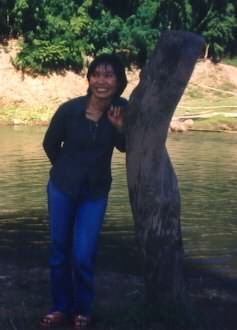
One of the problems with growing rice is that the men are unempleyed most of the year while they are waiting for the rice to grow.
Vinchu is working for the Swiss Red Cross. She intends to buy a piece of land in the 32-kilometre village of Muang Xai, and convert it into a fish farm. This would keep some of the men occupied for most of the year. The profit from the fish farm could be used to take care of the village’s basic needs such as education of the children and bu
Perfect Moments Photography | A Rene Pallesen Journal
Perfect Moments Photography | A Rene Pallesen Journal